
The Grand Canyon is a cathedral of stone, wrought by time, pressure and eons of geologic history. I had unfinished business, a yearning akin to unrequited love, deep in the recesses of the Canyon.
Decades ago, back in the 1990s, I rafted upper and lower segments of the Canyon on consecutive year’s trips and had always wanted to see what I missed. As then, it probably still requires at least a year’s advance planning to score a spot on a commercial trip. Back then, I signed Steve and me up for a dory trip with Grand Canyon Dories and simultaneously waitlisted us for 2 spots on an earlier AZRA trip. Unexpectedly, we cleared the waitlist, which is how I came to do 2 trips in consecutive years. Steve couldn’t get away from work for the AZRA trip, so I recruited my friend Jan for a rowing trip starting at Lee’s Ferry and terminating at Phantom Ranch in an arduous hike out the Bright Angel trail in extreme September heat, one trudging step after another, 7 long and strenuous miles. We regretted not having an extra day to allow our packs to be carried out by mule, which would have made the hike more tolerable, if not fun. But we both were newly in practice and had to be back at work on Monday, so we sucked it up and labored our way up and out of the Canyon. Another distinct memory from that trip with Jan is overindulging in Indian food the night before putting in at Lee’s Ferry. We both enjoy trying a variety of flavors, but that night, we got carried away and really over did it, so much I could hardly sleep.
The trip Steve and I did the following September was at the other end of the Canyon, helicoptering in at Whitmore Wash and taking out via jetboat on Lake Mead. That trip was notable for both of us having terrible hay fever, probably brought on by mold on the canvas walls of our covered wagon accommodation at the Bar 10 Ranch. By the end of the trip, we were rationing tissues.
Wes, a guide on our pandemic year Grand Canyon North Rim mountain biking camping trip over Labor Day of 2020 recommended a book, The Emerald Mile by Kevin Fedarko, which brought a flood of memories from those prior trips to the forefront of my mind and sharpened my resolve to run the Colorado again before many more years passed. Even in my 30s, I found the side canyon hiking in the Canyon to be strenuous and challenging, a situation not likely to improve with the passage of time. The Emerald Mile weaves together Grand Canyon and Four Corners region history through the lens of a historic speed run through the Canyon by 3 guides, who timed their escapade to record setting high water flows in 1983, which threatened to overflow Glen Canyon Dam. The year of the pandemic saw us regrouping, cancelling trips to Namibia, Chile and British Columbia, and pivoting to the Southwest’s backcountry, leading us back to Bryce and Zion, and visiting for the first time Lake Powell, Moab, Arches, Canyonlands and the North Rim of Grand Canyon. The Emerald Mile tied together stories from all of these regions, leaving just a rafting trip through the Canyon itself to complement the narrative.
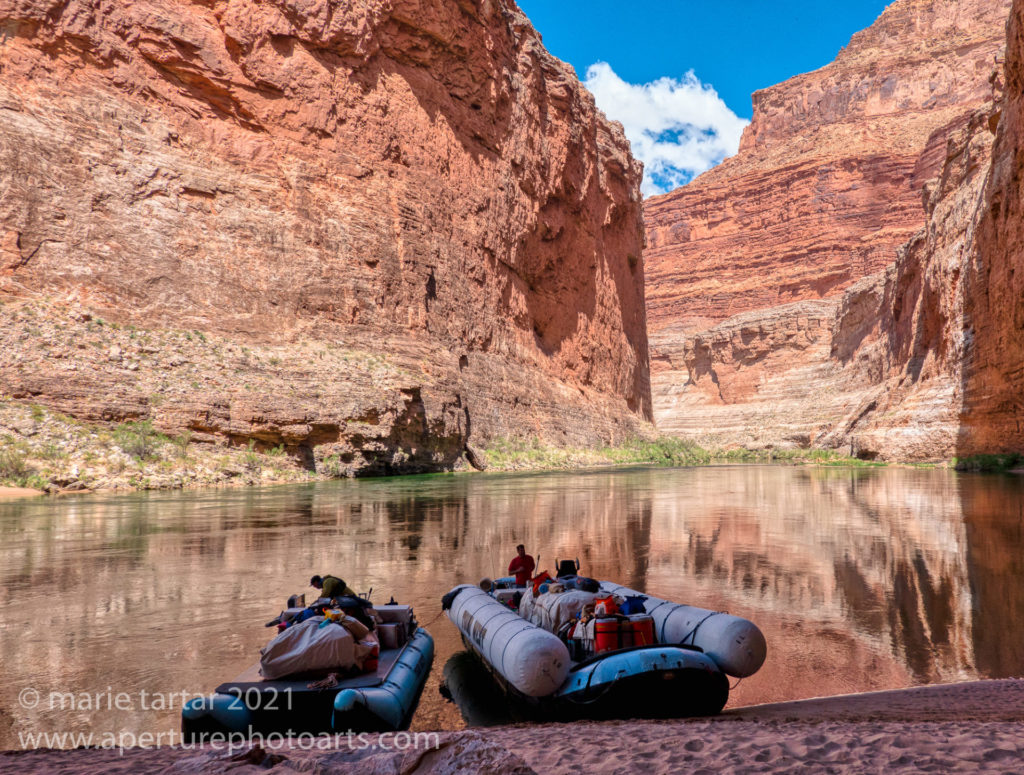
Our Tour West motorized vessels, the Baby J on the left and the S rig on the right, loaded with provisions for 18 people for 10 days, parked at Redwall Cavern, an immense natural amphitheater at Mile 33.
I was to think of this title often during our voyage, not only as our guides told us stories from the canyon, but for the color of the river, a meandering emerald ribbon, sometimes tranquil, occasionally violent. The water’s color was a sharp contrast to my recollection of it’s pinkish muddy color of my first trip with Jan. A favorite white T-shirt was forever transformed to a murky faded mud color after I dunked it in the river prior to our starting our ascent toward the rim.
In September 2021, I started an Internet search for a trip, which is how I connected with Adam Schallau, who had a trip which fit the bill (10 days) but it was fully booked. I waitlisted. At New Year’s, I wrote Adam to see if there was any movement. My timing was good. Pandemic related travel restrictions would keep a repeat client from Switzerland from claiming his spot and the person in front of me on the waitlist had work constraints-I was in!
And thus began the serious work of preparing for this trip. One would think I’d have a leg up given we spend so much time underwater and have wardrobes of neoprene. But underwater photography and photography on and around walls of unpredictable water are two different beasts. My underwater camera in its metal Nauticam housing is heavy and cumbersome out of water. Adam advised thinking in terms of a “boat kit” and a “hiking kit”. The hiking camera part was easy, as I do all my “serious” photography with my trusty Fujifilm XT-4. I devoted a ridiculous amount of time to agonizing about the “boat kit”. We already owned the Olympus TG-6 as an underwater back-up camera. It is small and waterproof, even without its housing. Adam mentioned a Sony RX 100V point and shoot as an example of a good choice for behind the scenes shots. I came seriously close to buying one, but having to learn a new menu system gave me pause. Greg came to the rescue, shipping from Chicago his RX100VI, complete with 6 (!) batteries, a charger and even a miniscule Nisi filter set. This camera isn’t waterproof but would give me a hiking back-up for the Fuji. Backscatter suggested a GoPro Hero 9, waterproof and hardy. I had reservations, having suffered with lemons of earlier GoPro models, but it seemed like maybe the newer versions were more reliable. Thus, not counting my Iphone, I took 4 camera systems on the Colorado, as follows: Fujifilm XT-4 with 3 batteries, Olympus TG-6 with 3 batteries, Sony RX 100VI with 6 batteries and a GoPro Hero9 with 3 batteries. I also took 2 auxiliary Ankar batteries and hoped this arsenal would get me through the 10 days without electricity. I used my Iphone for taking notes and for Photopills.
Special luggage was recommended and acquired, sealable waterproof Watershed duffels for camera gear. Drybags for clothing and bedding were provided. I spent hours before the trip learning the new systems via YouTube.
Monday April 26, 2021
Flagstaff
Adam and his wife, Sally, arranged a meet and greet dinner in Flagstaff at a restaurant with a private room, Fat Olives. Arriving at 5:15 pm, we thought we were early, but as almost everyone was already seated in the dining room, I suspect the time had been changed at some point. The bread, lasagna and brussel sprouts were heartily satisfying. As we were leaving at 6:30 am the following morning, we had decided to stay overnight in Flagstaff, rather than shuttling up and down Oak Creek Canyon in the dark. We spent a miserable night in a small room at the historic Monte Vista in downtown Heritage Square, which was a surprise as we both had great memories of a prior stay. The bed was so small, Steve dug into my packed drybag to unearth my sleeping bag to give the floor a try. It didn’t prove a great alternative. Just as we were edging toward asleep, drunks in the hall raised a ruckus, which seemed to go on all night.
Tues April 27, 2021
Day 1, Lee’s Ferry to North Canyon Camp, Mile 21
Awakening at 5:15 am the following morning, I was startled to see white streaks outside in the pallid light- snow! A multi-colored freight train of interminable length delayed our arrival at Ceiba. Just when we thought we were in the clear, a second, equally languid and elongated train lumbered in the opposite direction.
Two Ceiba vans transported us north to Lee’s Ferry, the temperature climbing with each mile. The drive gave me a chance to become acquainted with some of our group, which numbered 12 clients, Adam and Sally and 4 guides, who awaited us at Lee’s Ferry. Joe rode shotgun. We would later learn that he had no idea what to do with the provided sleeping bag on the first night, this being the 74-year old’s first ever camping trip. “Pepito”, a short and cheerful Filipino who divides his time between Minneapolis and Sacramento, adapted quickly, becoming something of a company mascot, including being dubbed Teaspoon to Scott’s Big Spoon and Chris’ Little Spoon. Art, a retired tech transfer professor from Penn State, beat Joe out by a few months as the most senior member of our party. Scott and Chris both hail from the Ann Arbor area and were very supportive and helpful members of our team, frequently helping the vertically and muscularly challenged among us with gear transfers between our landing and our camp sites. “Billygoat” Brian, a TV weatherman from Cape Girardeau, MO, was on his 3rd Grand Canyon rafting voyage, as was Jan from Colorado. Jim, retired from Shell, was apart from his wife on their monthly wedding anniversary for the first time in decades.
Our party was rounded out by two couples, Gordon and Donna from Oklahoma and Ann and Bill from Phoenix. Gordon and Donna, married for 40 years, have 2 college age children, one of whom was minding the dog back home. Ann and Bill, together for 3 years, met at the Phoenix zoo on a photographic outing.
Our 4 guides were a diverse but complementary and thoughtful bunch, consisting of trip leader John (aka “Bugs”), a fellow U of AZ Wildcat and PhD geophysicist and former oil company veteran; Kyle, father of 6, with a raucous sense of humor, who noted he was the only person we would ever meet who had been squirted by an albino skunk, and two Jakes, both muscular, agile and knowledgable. The shorter Jake, with blue eyes and long curls, was noted to resemble how Jesus is usually depicted. He also could quote long passages of poetry extemporaneously, as Art and I learned when he hung back at the tail of the group on hikes as the sweep.
Passing under the the pedestrian Navajo and vehicular Marble Canyon Bridges, swifts circling overhead saw us off. We were to see more wildlife than I remembered from prior trips, especially desert bighorn, usually seen drinking at the river’s edge and sometimes seen, mostly by our sharp-eyed guides, sheltering from the sun in the shade of sandstone ledges. Every evening, bats circled overhead, keeping our campsites relatively insect free. These I remembered, having commented to Steve years back (without my contacts, all I saw was a series of blurs darting about): “Those moths are HUGE”, while he debated whether to tell me they were actually bats. Each campsite was favored by a resident pair of common ravens. Our arrival would drive them off, only to return to forage on the beach as soon as our boats slipped off the sand the next morning.
Ducks skimmed the surface of the water and we had occasional sightings of American avocets, as well as a great blue heron and a peregrine falcon. Tiny red spotted toads were occasionally found and agile lizards darted around, mainly whip-tailed and collared.
For our launch, I traveled first in our big boat, the 37 foot S rig, on which rode the majority of the passengers, with 2 guides. Other than Sally, who consistently took up a defensive (presumably drier) position in the stern next to the boatman, most of us rotated in and out of the more forward positions toward the bow, receiving periodic and thoroughly shocking drenchings. The smaller, more nimble 22-foot vessel, dubbed the “Baby J” usually took 2-4 passengers and 2 guides. Our gear was segregated by boat, with the camera bags riding on the Baby J, lashed down under tarpaulins, with most of the rest of the gear inaccessible during the day, being stowed on the S rig. This was a great photographic advantage over the Visionary Wild photo trip group, with which we hopscotched the first few days, traveling on a single AZRA vessel. Smaller day bags were lashed with carabiners to the cinches securing the pile of bags. The cinches were also used by us to brace ourselves during passages through white water. Traveling on motorized vessels will allow us to traverse 225 river miles in 10 days. Adam and Sally usually cover this same distance on an 18-day oar trip. As for me, a voyage of that length will have to wait until retirement, time being the ultimate luxury, so I am happy they have made this accommodation to the working. This is also the longest camping trip I have ever undertaken. The regular dousings from the bracing (48 degrees!) river water made staying reasonably clean easier than I anticipated. This was my first motorized trip.
We stopped for lunch en route this first day, although this would not be our routine most days when a photographic destination hike was planned. Sandwich fixings were provided from which I sampled a vegetarian Tofurkey lunchmeat product with avocado on Dave’s killer bread. I will always associate this bread with camping trips, having first encountered it last year during our mountain biking camping trips. Even on this first, relatively calm stretch of the river, there are reminders of earlier explorers, a number of whom drowned and are memorialized by carved notations. At Mile 12, an inscription scratched into stone can still be read, commemorating Frank. M. Brown, president of a Denver railroad company, who died in 1889 while conducting a survey for a river-level railroad to transport coal from the Rockies to LA. Imagine how different the Canyon experience would be if a project like that had ever come to fruition. Also notable was that the inscription itself was carved by a survey crew member, Peter Hansbrough, who drowned in another accident only 5 days later. He is commemorated in the naming of Point Hansbrough at Mile 44.
Our camp at North Canyon, Mile 21, was already occupied by a group stopping for lunch. We set up camp while the other group hiked up the side canyon backing this site. Bugs used my cot to demonstrate its set-up; these cots by CampTime are a rather ingenious, low-tech design of interlocking poles and mesh which sheds sand well. When the other group returned, we were ready to set out on our first hike, to the North Canyon reflecting pool. It was a challenging hike with scrambling, which turned Jan back, but I was glad I had persevered when I saw the sculptural rippled array of stone doubled by reflection in a still pond at its foot.
Despite the scrambling, I never warmed up enough to shed my fleece jacket, which dates back to our first Antarctica trip in 2003. For dinner, the guides conjured up hotdogs and hamburgers, with potato salad.
Wednesday, April 27, 2021
Day 2, North Canyon to Carbon Camp, Mile 65
It was a cold night despite wearing my fleece jacket to bed, with a fleece buff and cap. I awoke at 1 am to startlingly bright moonlight, easy to navigate the camp on foot, even the sandy path riverside past Jim’s camp to the “world’s most beautiful bathroom “. Everything, including solid human waste, must be packed out. We have a bathroom situation improved over my 1990s trips. In addition to a Groover for solid waste and toilet paper, we have a pee bucket for the ladies, the contents of which go in the river. The trick was to remember not to jettison the paper into the bucket so the guides wouldn’t have to fish it out before emptying the bucket. Amazingly, I only forgot once and that was when I used a square to wipe off a drop on the seat (presumably urine) left over from a prior user. Before I knew it, the square was in the bucket, as quick as a reflex.
Since I was up and the Canyon was so illuminated, I stayed up to take some moonlit shots with the stars.
I slept fitfully, a little warmer after putting the pad on the cot after my nocturnal photoshoot, until voices of the departing sunrise shoot group awoke me. A tiny headache earlier in the evening warned that I might be dehydrated. After pushing water in response, of course I needed to pee. I heard Brian say to Adam that he would catch up with the group as I headed toward The Key and The Groover.
Returning to my camp, I found Art nearby, geared up, looking wistfully in the direction of the receding headlamps. He mentioned Adam’s response to Brian had been “No, we need to go as a group.” We weighed trying to follow without knowing exactly where they were headed and remembering the exertions and obstacles of the prior day, decided against.
Breakfast was hearty, with hash browns, bacon and eggs scrambled with peppers. We assembled lunches into Tupperware containers for later consumption (chicken salad on Dave’s killer bread with bacon and avocado).
On the river again, we made a short scramble up to a grey stone ledge with very recognizable fossil impressions of earlier marine life. Chris slipped on exiting, sacrificing a Canon lens in the process.
Vasey’s Paradise, a waterfall with a sometimes lush hanging garden, was reduced to a trickle.
Our morning stop at Redwall Cavern turned into our lunch stop. Adam accentuated the shoreline ripples with water scooped up in bucket.
Our intended camp destination was Nankoweap, named for the cliff-side granary. The camp was occupied, nixing the related plan to hike to the Puebloan granaries dating to AD 1100. I remember visiting this site on my prior trip. Brian, who loves ruins, was particularly disappointed.
Plan B, Kwagunt, also was foiled. Even an attempt at a tricky landing was overcome by the strong current, impelling us down river.
Plan C, Science Camp, was where it was planned for us to spend the following night. Another photography group was already installed. We pulled up alongside, for Adam to confer with their leaders.
Along the way, Adam vetoed, after conferencing ashore with John, what looked to be a beautiful campsite, warmed by the late afternoon sun and situated to have hours more. I would have taken this bird in the hand in a heartbeat rather than risk disappointment further downstream. The other photo trip leaders mentioned the nearby Little Colorado River was beautiful and indeed it was. We stopped off for an hour to admire the distinctive pale blue of the Little Colorado.
This confluence of waters is also the site of an event which influenced modern history. In 1956, there was a mid-air collision of a TWA plane with a United Airlines flight, leading to the creation of the FAA.
This is how we ended up at Carbon Camp, Mile 65, for the night, putting us ahead of the planned itinerary.
I was cold all day, being on the big boat, receiving drenchings of ice-cold water at regular intervals. Having to wade into the river to pee alongside the boat toward the end of the day didn’t help. Back at camp, I grabbed the first level campsite, which turned out to be next to the kitchen and the circle of chairs. My focus on disembarking was to clean up the camera gear, change the go Pro‘s batteries and wash my hair while it was still light. This I accomplished down by the river with the help of warm water, hoarded since breakfast time in my thermal cup. The proximity to the kitchen probably also contributed to the frequent visitation to my camp of a tiny mouse.
Dinner was fish, a choice of tuna, tilapia or orange roughy, cooked on the grill, with sautéed zucchini, mashed potatoes and Caesar salad.
After dinner, John walked me by headlamp up the canyon behind our campsite, where I took a few canyon and star images. Afterwards I shot down by the river, trying a 15 minute exposure.
Thursday, April 29, 2021
Day 3, Carbon to Cardenas Camp, Mile 71
Our first two days, it was hard to believe we would ever be warm again. Today, we became believers. We transitioned from the chilly to the warm to the hot canyon very rapidly. We had progressed so far down river on our marathon prior day that it was but a short run to our next intended campsite, Cardenas, named for the first European to see the Grand Canyon in 1540. This was a hot and sunny camp, leading the group to shelter under a pop-up canopy. Jan, Art and I had to relocate after initially selecting the kitchen as potential camp sites. Down a sandy path, I found a “private room” formed by twisting trees and shrubbery.
Sally made a public service announcement, warning the ladies that she was near branded by the searing hot black plastic of the toilet seat at the pee station. Even the water for hand washing became scalding. Chris and I waded into a shallow lagoon formed by a semi-circular sandbar. The muddy shallows pulled hard at my sandals as I wobbled trying not to slip on the algae while washing my hair.
We waited until the sun’s intensity had abated somewhat before heading out at 3 pm for a hike up to a viewpoint overlooking the Unkar Rapid at Mile 73 and the Unkar Delta on the opposite bank. This was a steady climb with good footing, an easy gravelly trail, but the heat was intense enough I was glad Bill and Ann had suggested before departing to wet my hat and hoodie before setting off.
Billygoat Brian made it first to an overlook of the sinuous bends of the Colorado, leading Chris, Scott and me over. We were later joined by John, Art and Joe.
The guides produced another amazing dinner, complete with BBQ chicken, fresh green beans, rice and coleslaw, with a Dutch oven cooked peach cobbler for dessert.
I left my tripod in place on the beach on a small patch of rock-free sand, trained on the Unkar Delta on the opposite bank, confusing Bill when he came to check on his rig. He initially mistook my lonely tripod on the beach for his, further down. I had taken my camera, leaving only the tripod, leading him to think for a moment that someone had taken his camera.
Returning to my camp in the moonless dark, I missed the turn separating my camp from Gordon and Donna’s. My hyperacute startle reflex went into overdrive, suddenly spying a man standing in the path. Initially, I was confused, thinking I had taken the path we descended from our hike earlier in the day. When Gordon said “Wrong camp” and I saw Donna, I knew how I’d gone wrong. Mortified, having effectively wandered into their bedroom in the middle of the night, I backtracked in the dark in a hurry, flustered and apologizing.
Back in my camp, after plopping down my camera on the cot, I plunked down on the nearest end of it. Mistake! I found myself down on the sand, pinning down one end of the cot, as everything I had left on it began rolling slowly down into my lap. I managed to intercept the camera as it tumbled. I had to stifle my laughter, as Brian was just over the next thicket. I set my phone alarm for 1 am, thinking the moon would be lighting the canyon walls by then. I caught a couple hours of sleep before awakening at 12:40 am. Reluctant to leave my warm cocoon, I struggled to pry open an eye. I hovered, on the verge of going back to sleep, then worried I might sleep through the progressively louder, escalating alarm. Not wanting to disturb the neighbors again, I reached for the phone, suspended in a meshbag off the side of the cot and struggled awake. The moon was so bright, it was easy to navigate the meandering sand path back to the beach.
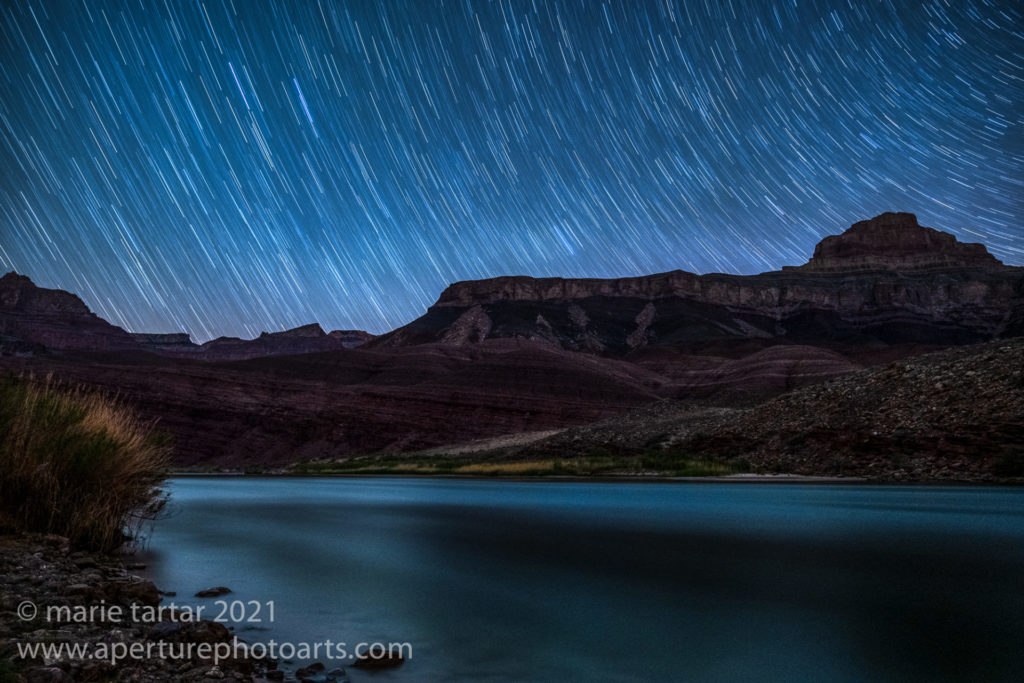
The view from Cardenas Camp, Mile 73, in Grand Canyon. Across the way is the Unkar Delta. The star trails were shot in the evening (15 minute exposure) and combined with a middle of the night moon lit landscape. I left my tripod on the beach between the exposures.

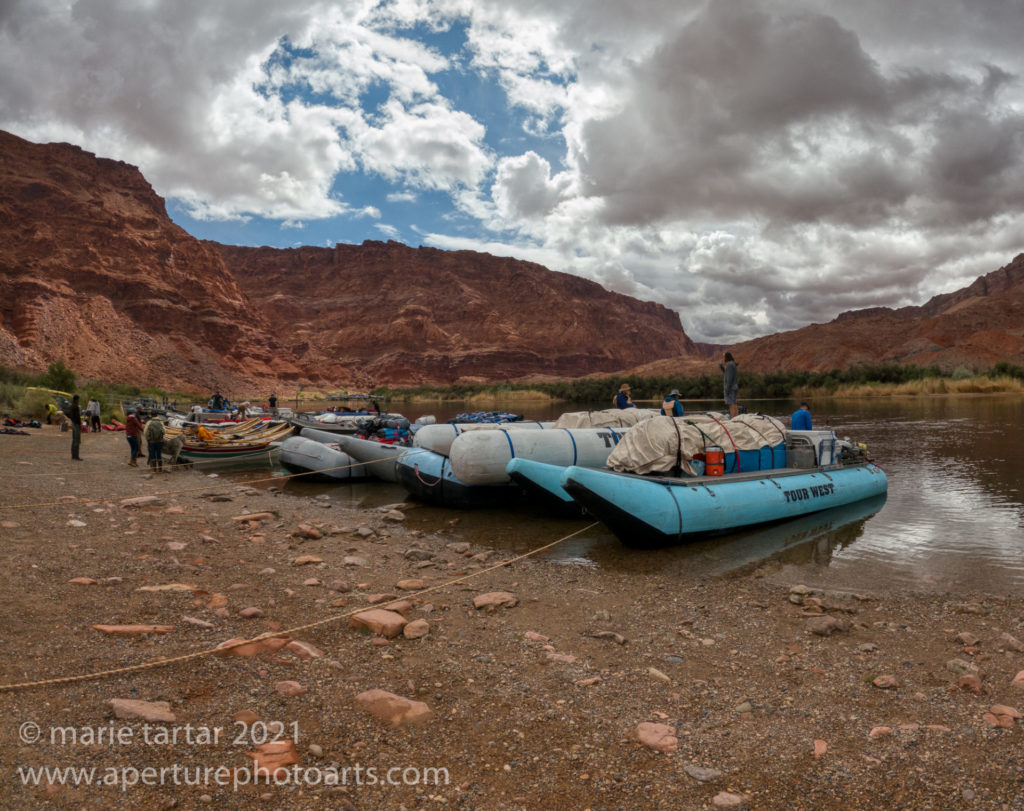
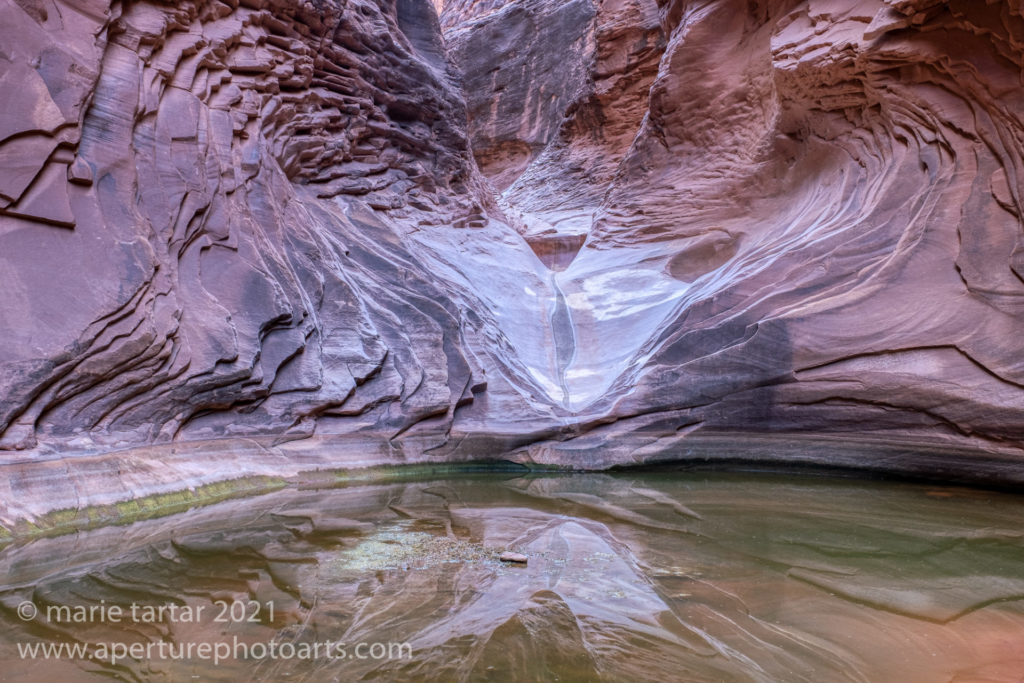
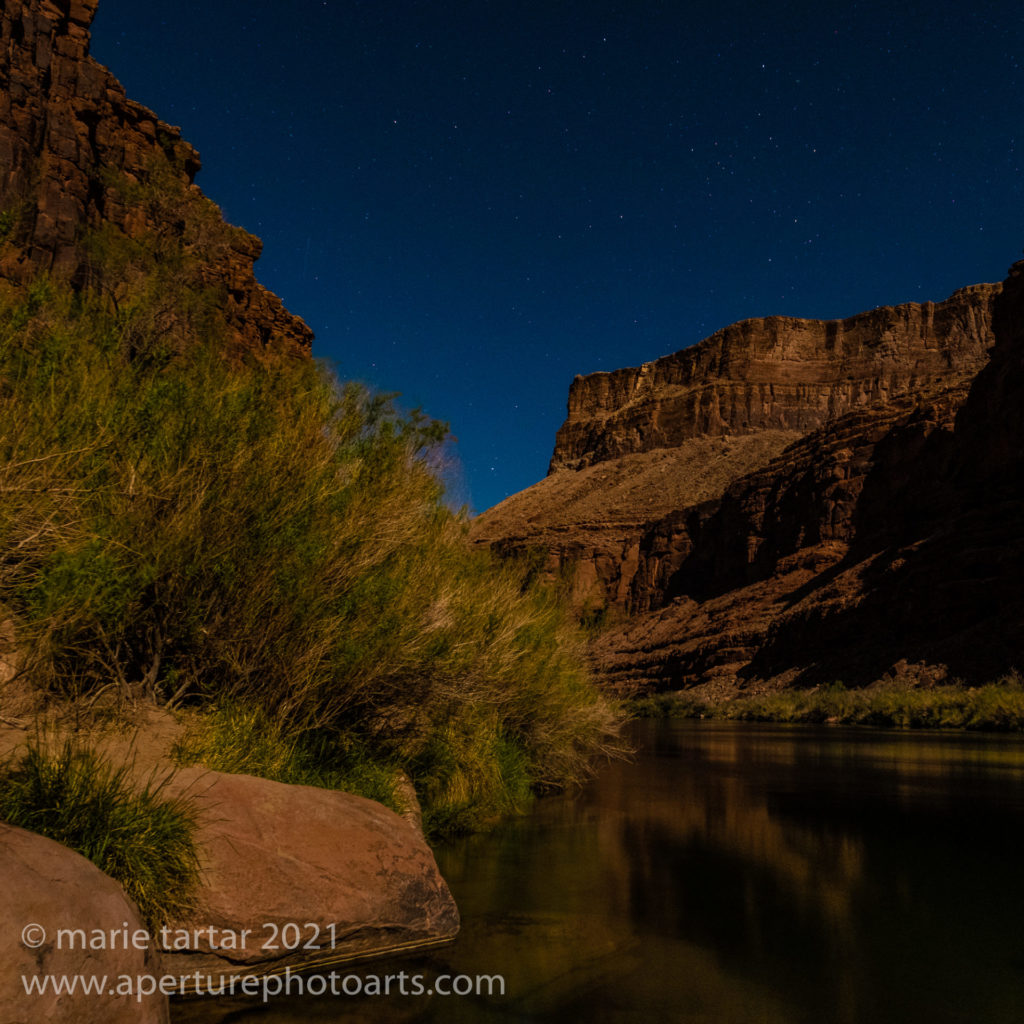
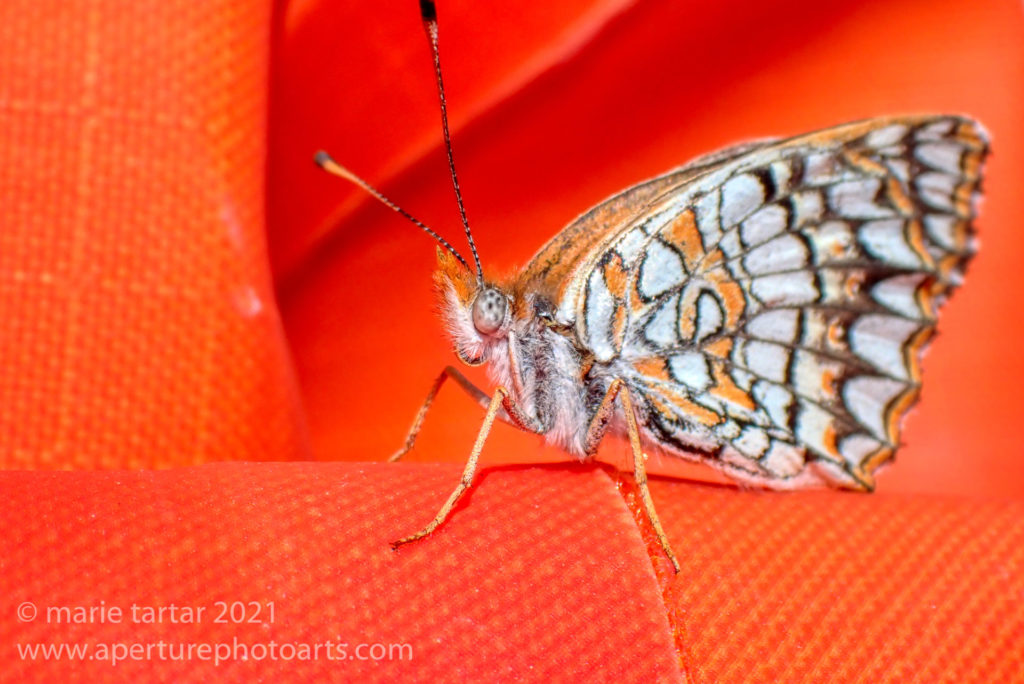



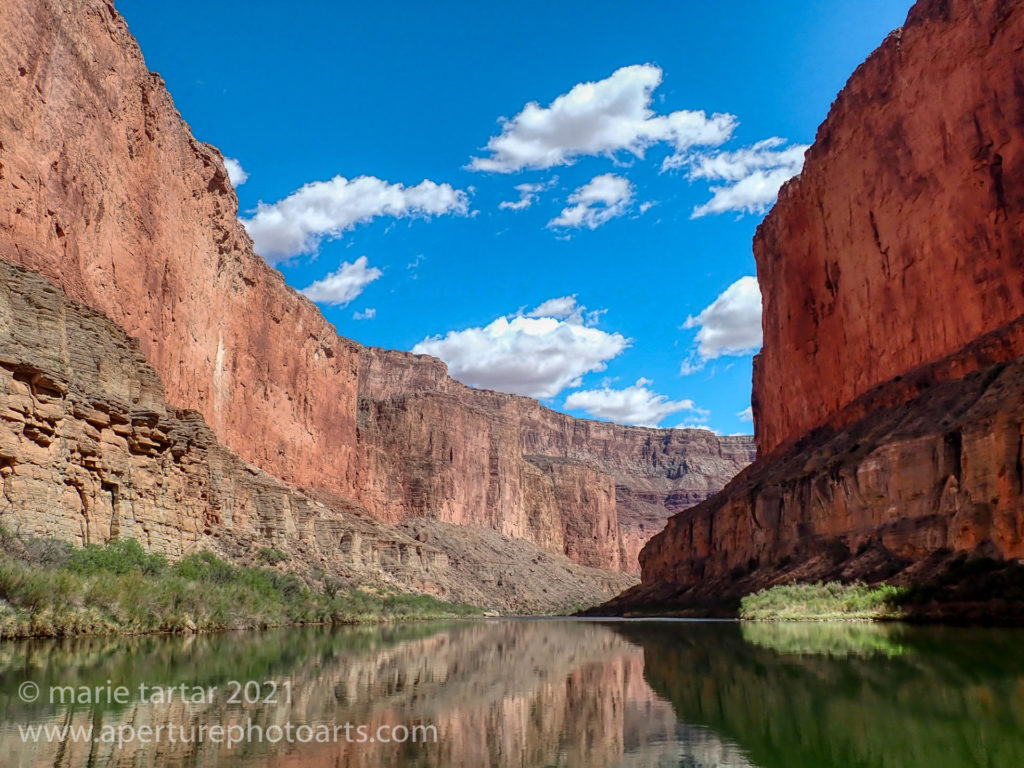

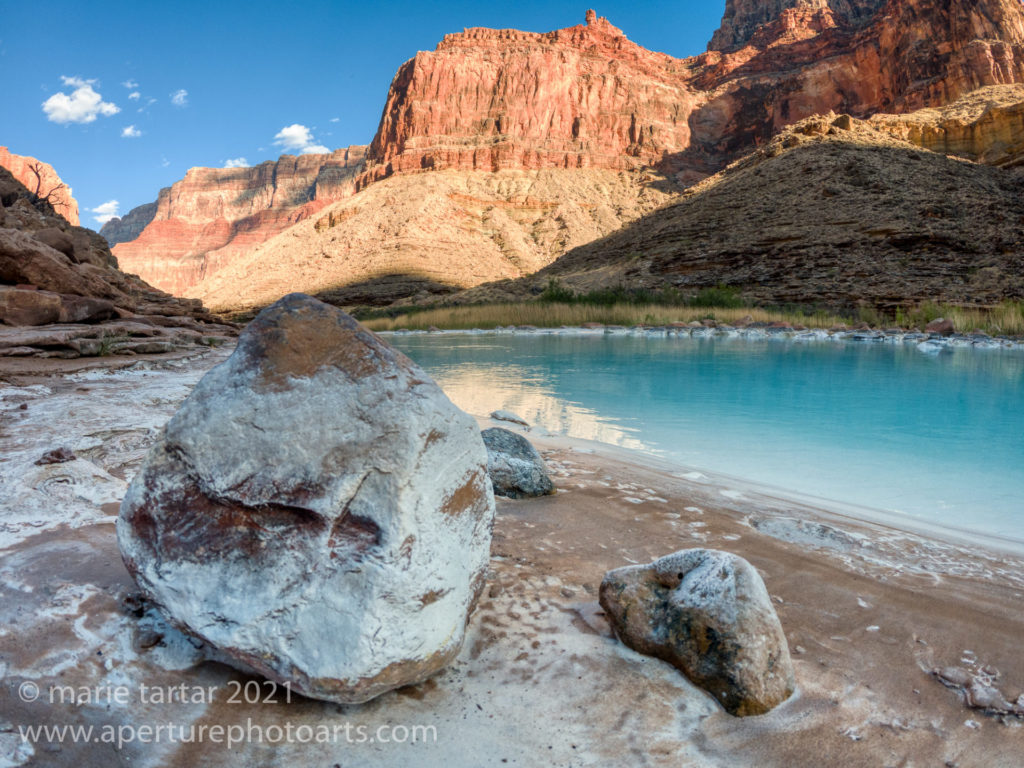
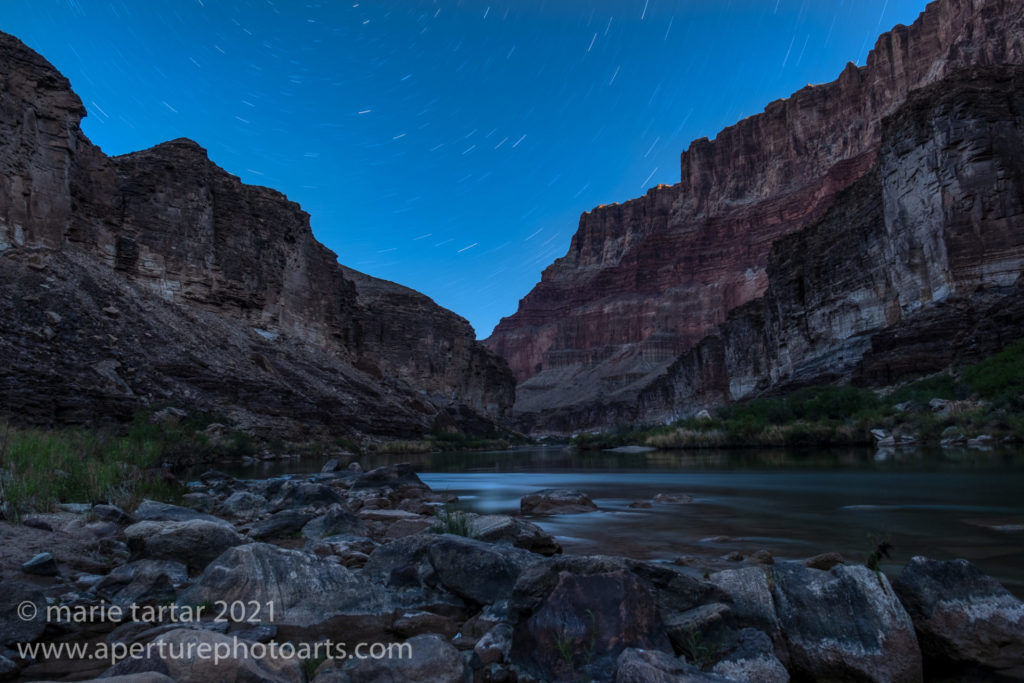
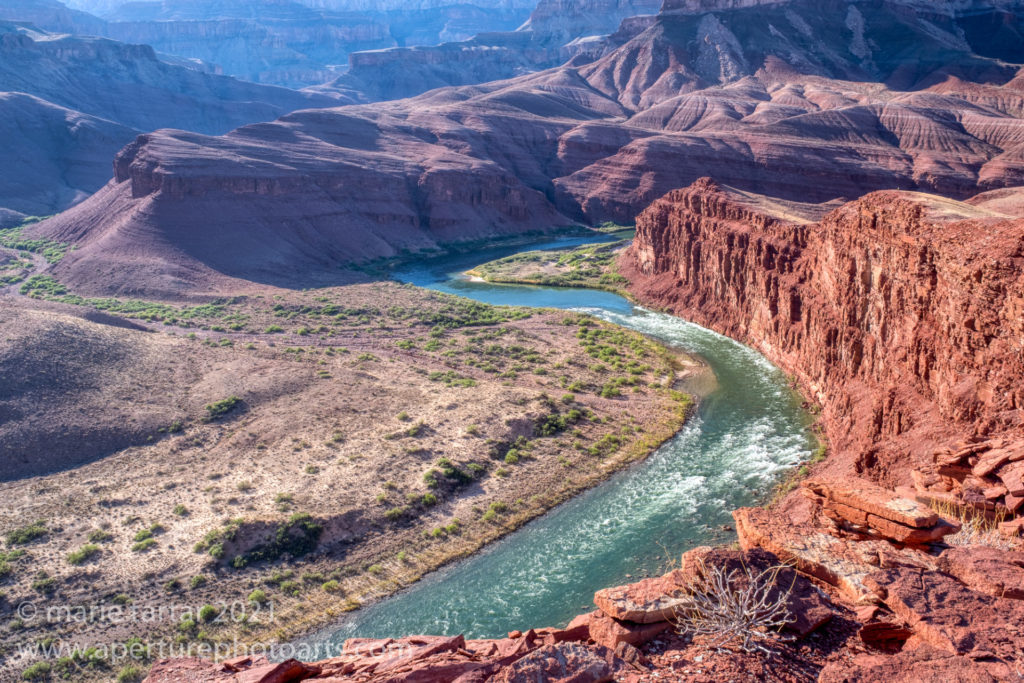
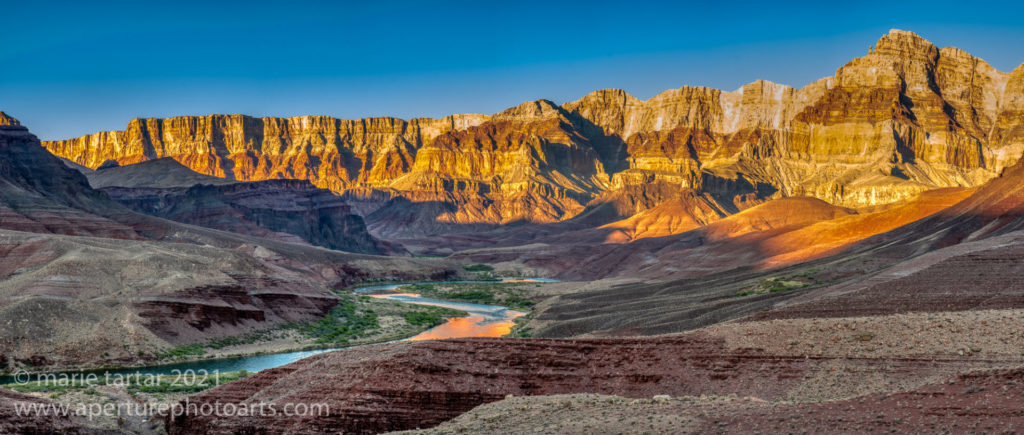
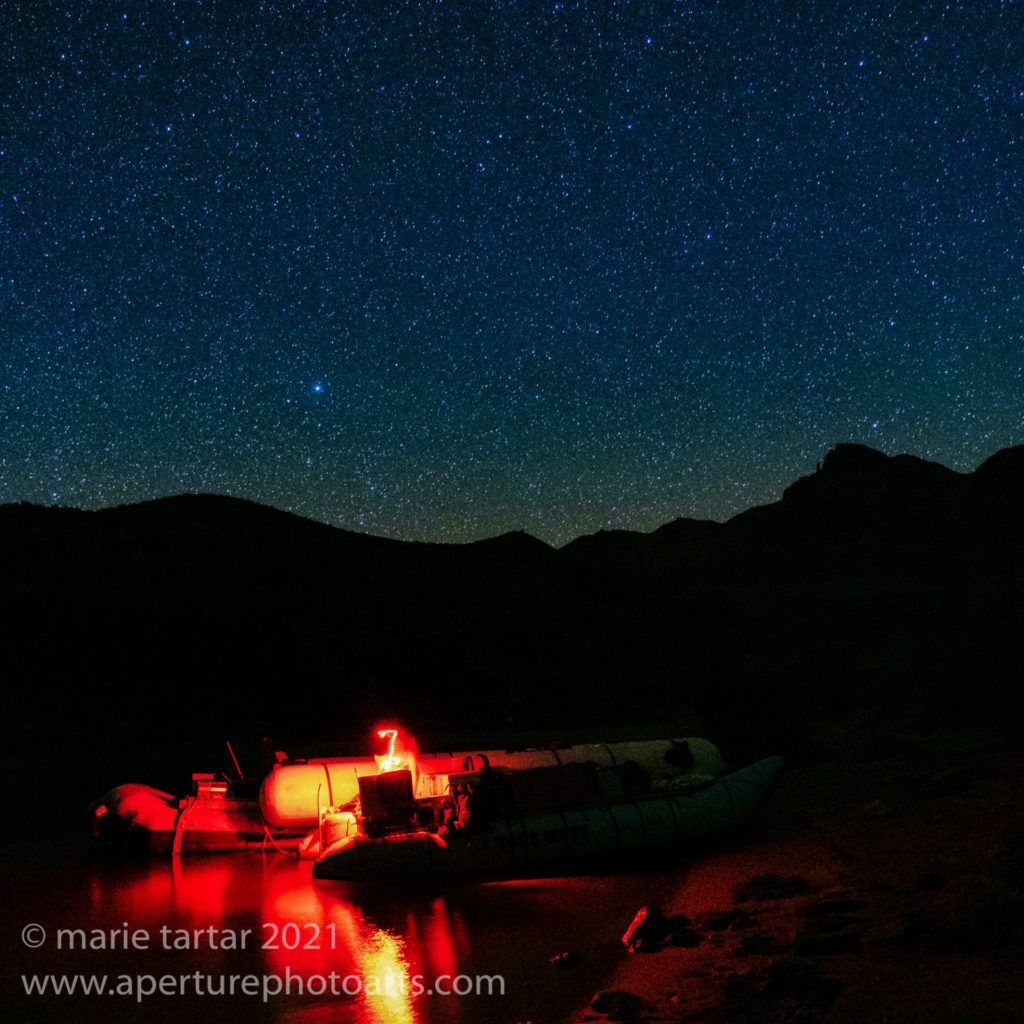

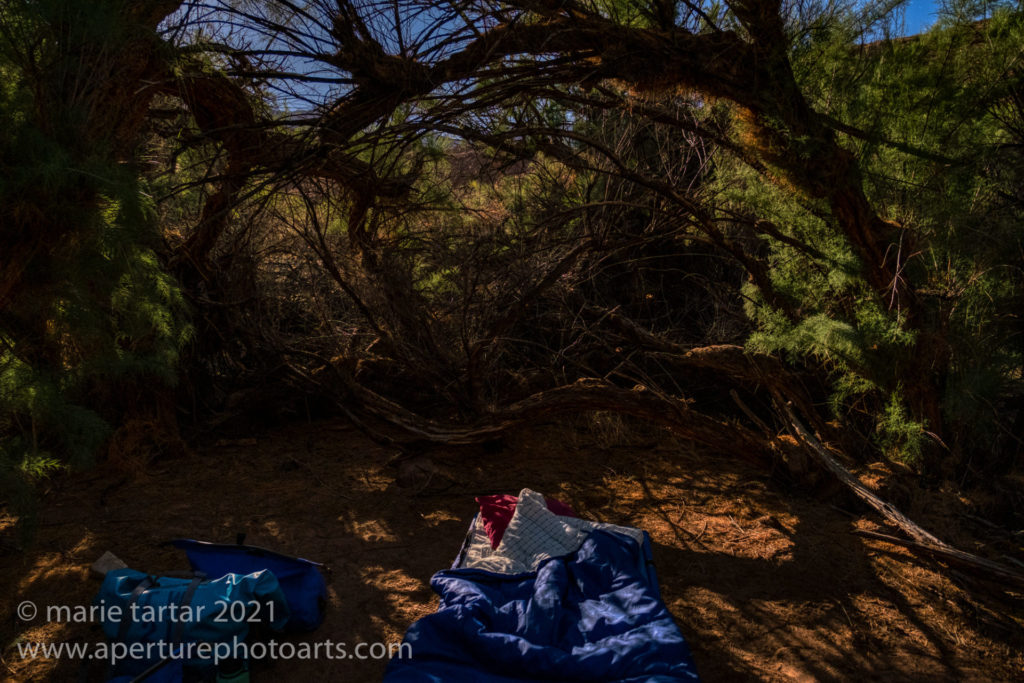
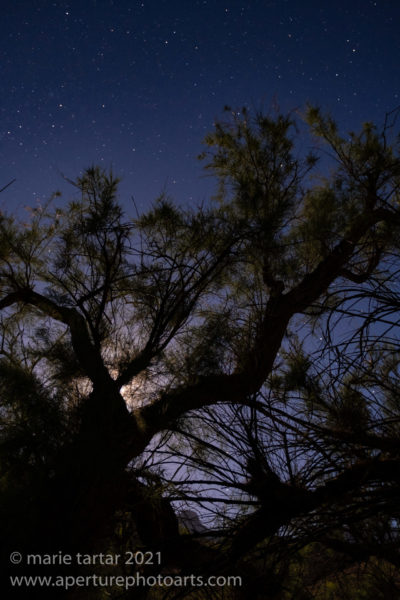
Stunning descriptions & photos! I feel like I was there. Thank you
This would be a great multi-generational trip to consider!
-Marie